maintenance TOYOTA PRIUS C 2012 NHP10 / 1.G Manual Online
[x] Cancel search | Manufacturer: TOYOTA, Model Year: 2012, Model line: PRIUS C, Model: TOYOTA PRIUS C 2012 NHP10 / 1.GPages: 552, PDF Size: 8.27 MB
Page 416 of 552
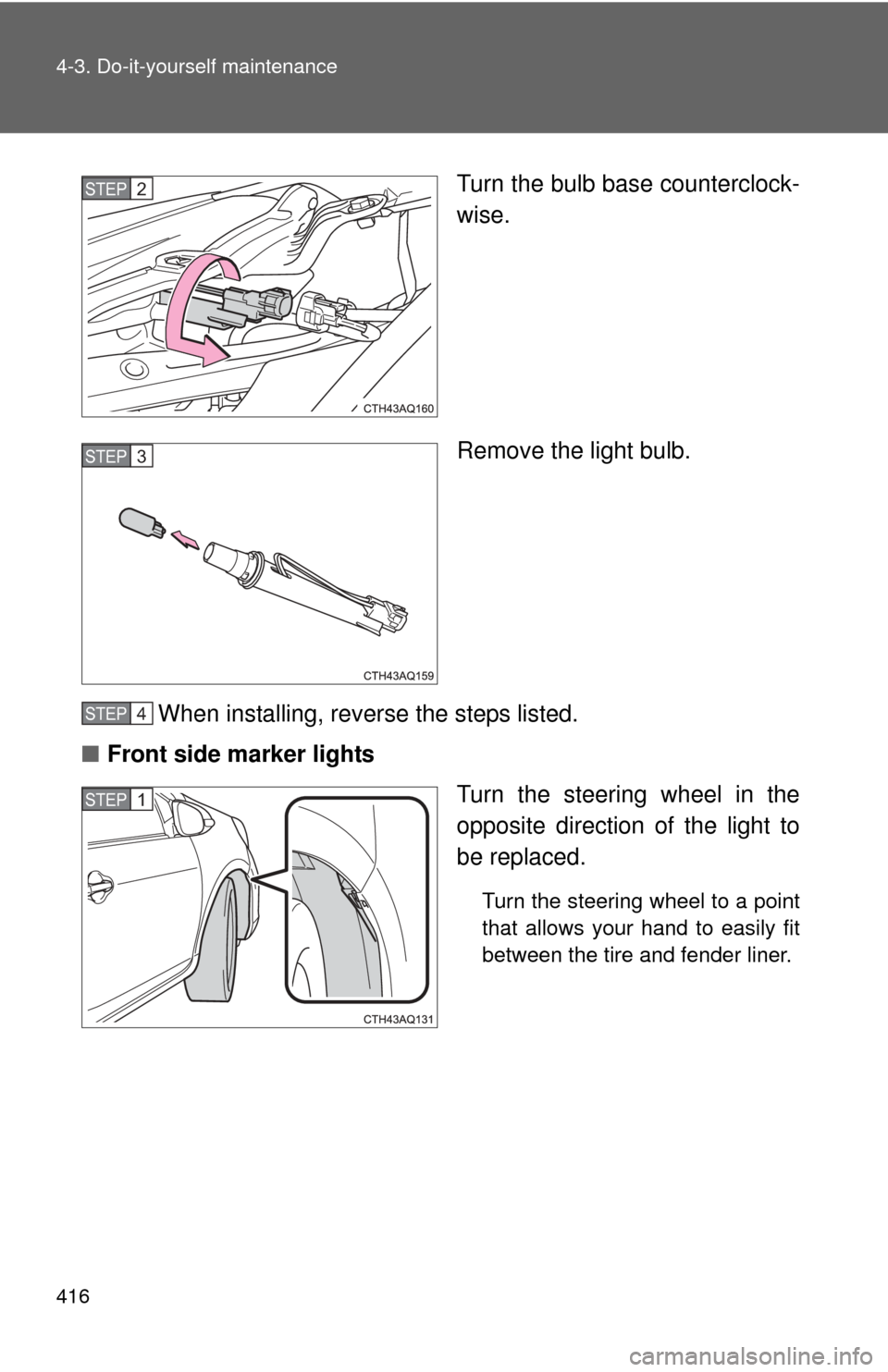
416 4-3. Do-it-yourself maintenance
Turn the bulb base counterclock-
wise.
Remove the light bulb.
When installing, reverse the steps listed.
■ Front side marker lights
Turn the steering wheel in the
opposite direction of the light to
be replaced.
Turn the steering wheel to a point
that allows your hand to easily fit
between the tire and fender liner.
STEP2
STEP3
STEP4
STEP1
Page 417 of 552
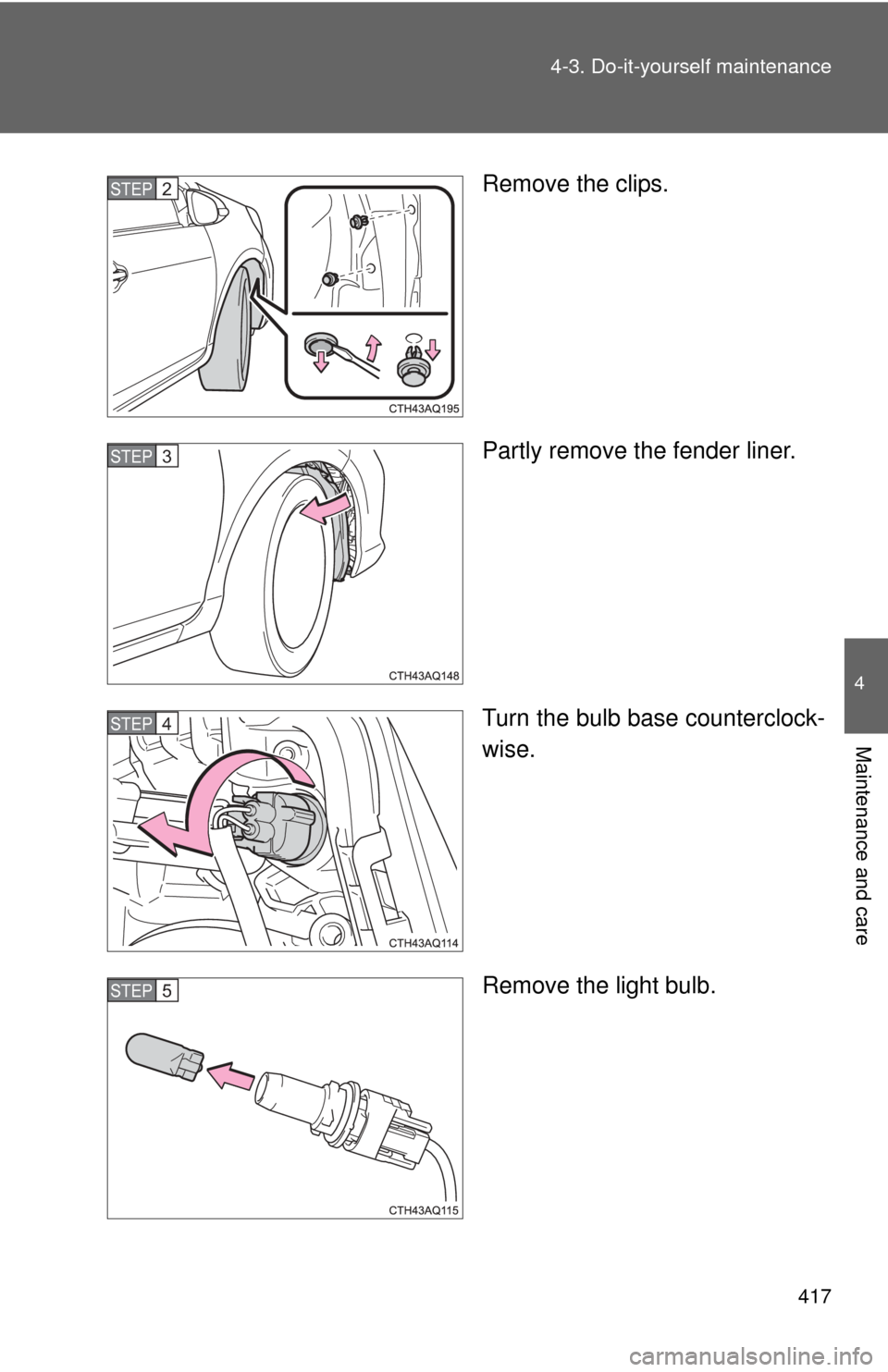
417
4-3. Do-it-yourself maintenance
4
Maintenance and care
Remove the clips.
Partly remove the fender liner.
Turn the bulb base counterclock-
wise.
Remove the light bulb.STEP2
STEP3
STEP4
STEP5
Page 418 of 552
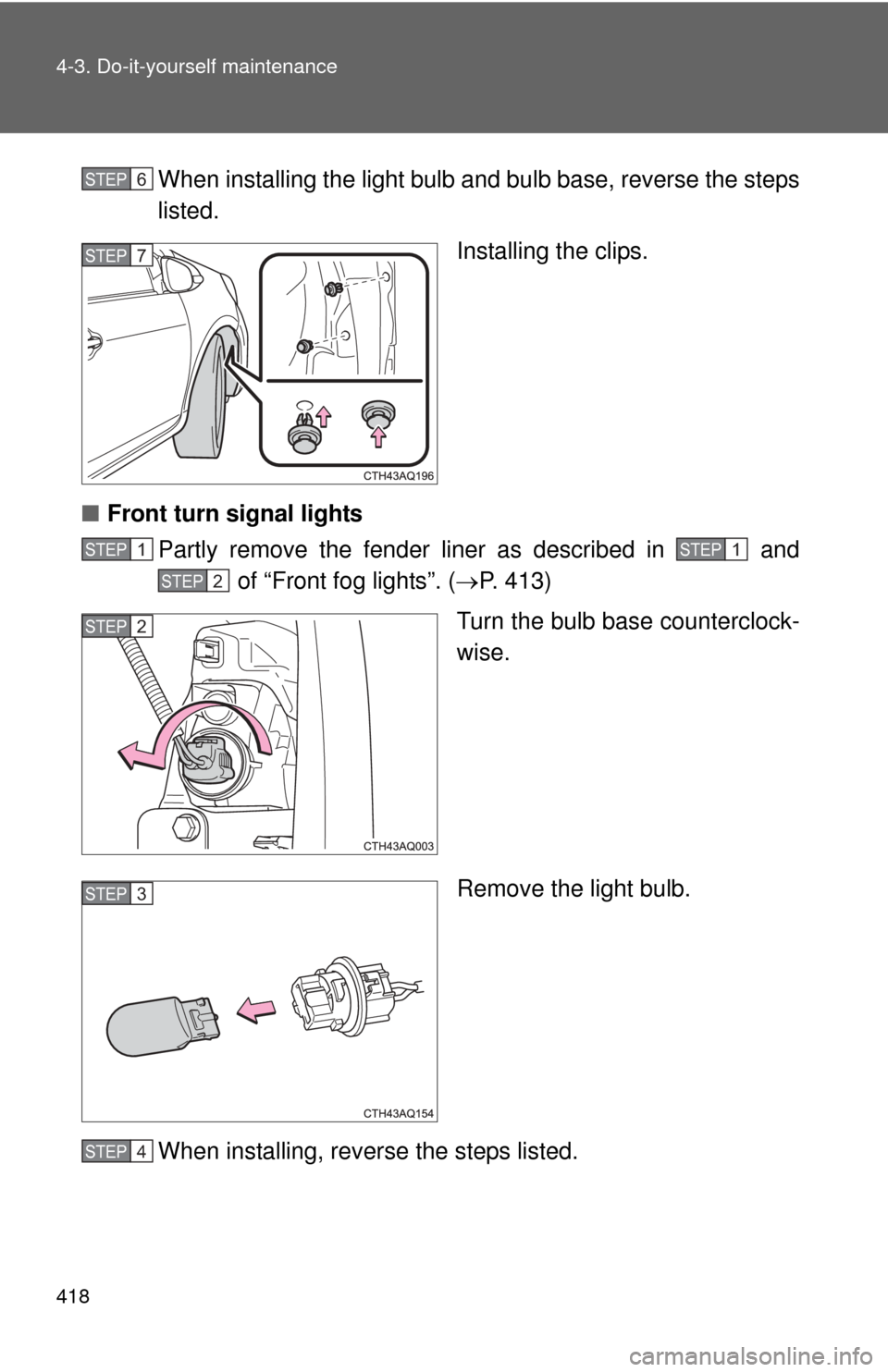
418 4-3. Do-it-yourself maintenance
When installing the light bulb and bulb base, reverse the steps
listed.
Installing the clips.
■ Front turn signal lights
Partly remove the fender liner as described in and of “Front fog lights”. ( P. 413)
Turn the bulb base counterclock-
wise.
Remove the light bulb.
When installing, reverse the steps listed.STEP6
STEP7
STEP1STEP1
STEP2
STEP2
STEP3
STEP4
Page 419 of 552

419
4-3. Do-it-yourself maintenance
4
Maintenance and care
■
Rear turn signal lights, tail a nd rear side marker lights, and
back-up lights
Open the back door and remove
the bolts. Pull the lamp assembly
straight back to disengage the
clip and 2 pins.
Where the clip attaches
Pin
Turn the bulb base counterclock-
wise. Rear turn signal light
Tail and rear side marker light
Back-up light
STEP1
STEP2
Page 420 of 552
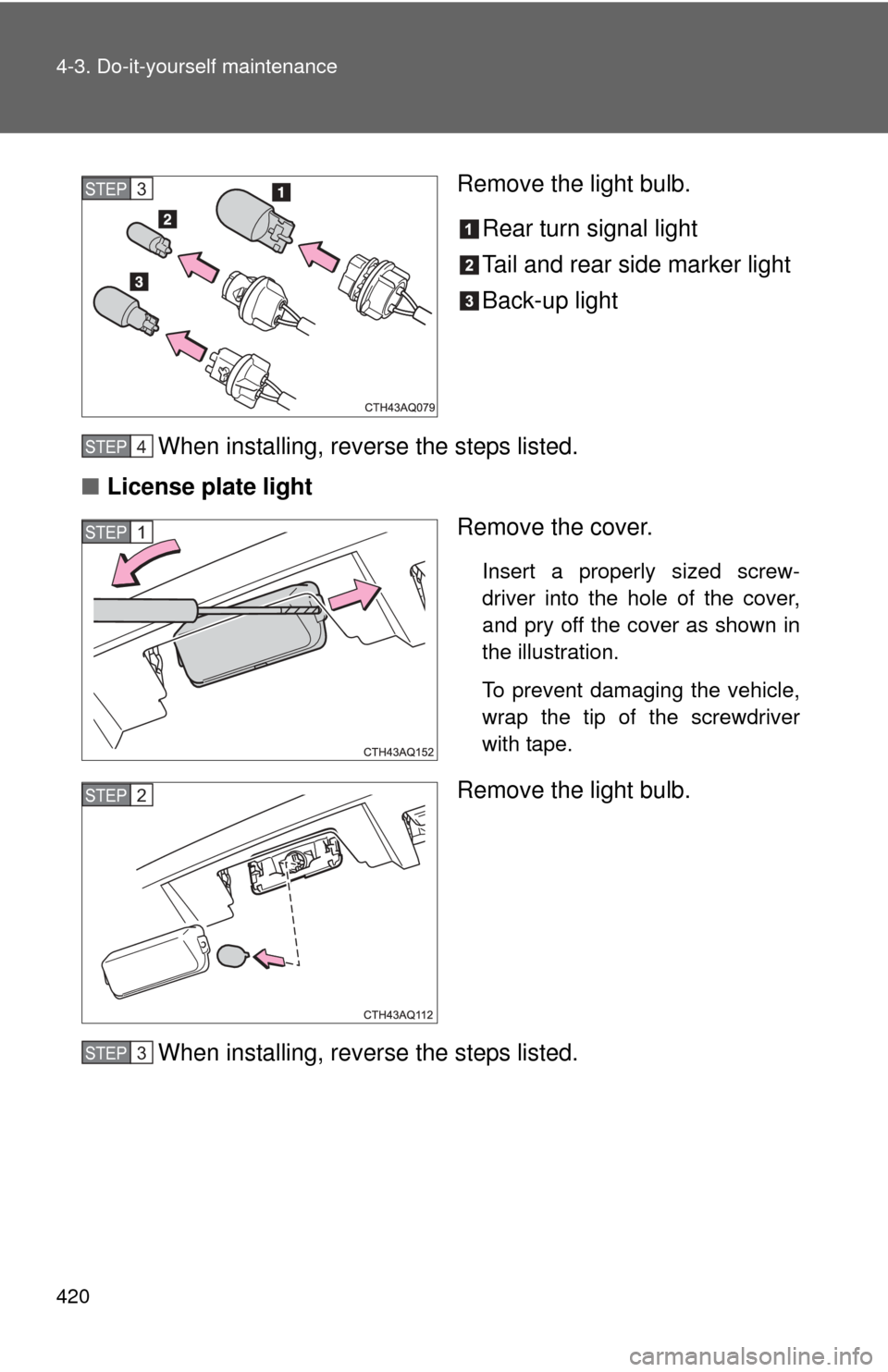
420 4-3. Do-it-yourself maintenance
Remove the light bulb.Rear turn signal light
Tail and rear side marker light
Back-up light
When installing, reverse the steps listed.
■ License plate light
Remove the cover.
Insert a properly sized screw-
driver into the hole of the cover,
and pry off the cover as shown in
the illustration.
To prevent damaging the vehicle,
wrap the tip of the screwdriver
with tape.
Remove the light bulb.
When installing, reverse the steps listed.
STEP3
STEP4
STEP1
STEP2
STEP3
Page 421 of 552
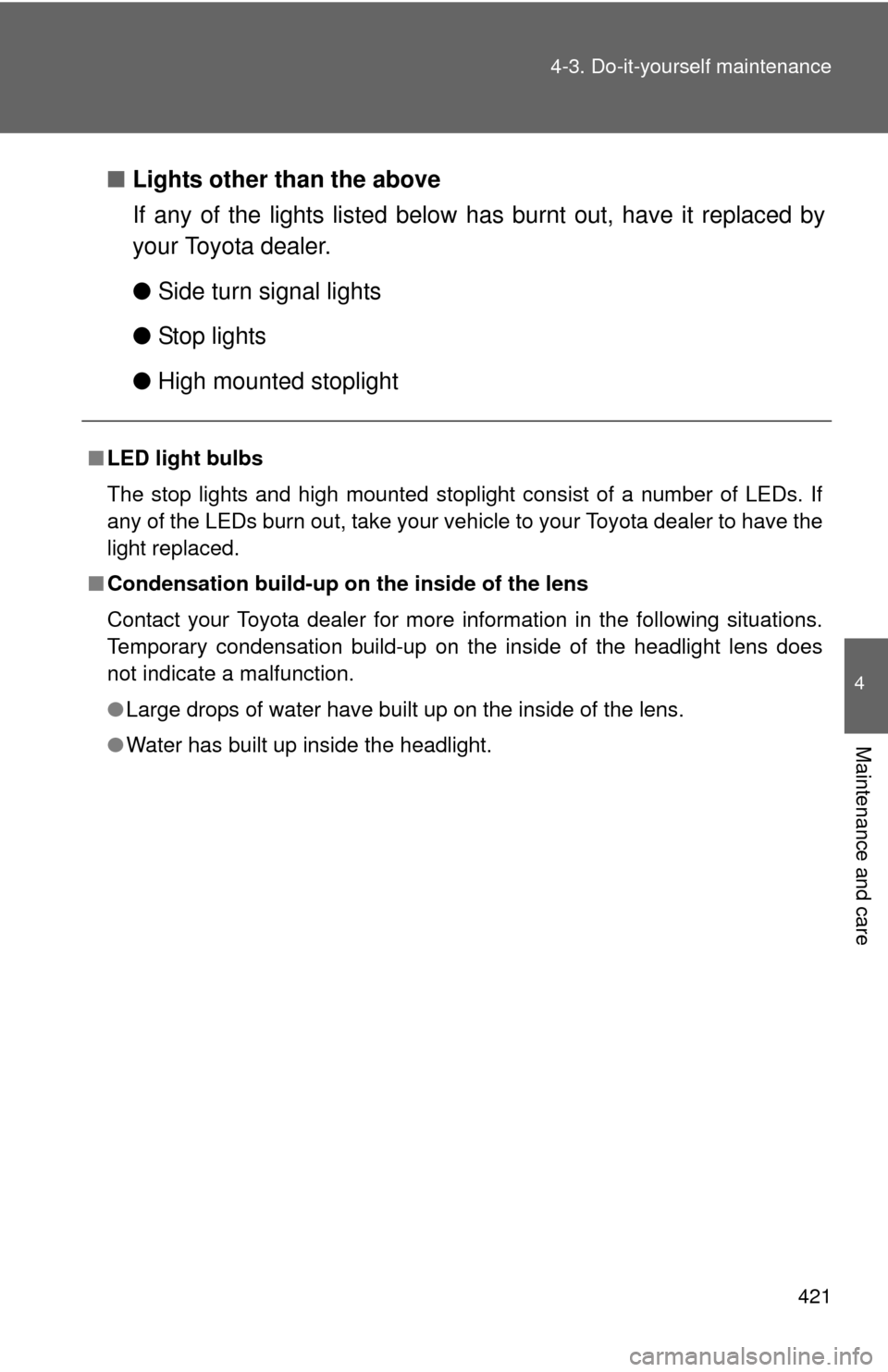
421
4-3. Do-it-yourself maintenance
4
Maintenance and care
■
Lights other than the above
If any of the lights listed below has burnt out, have it replaced by
your Toyota dealer.
● Side turn signal lights
● Stop lights
● High mounted stoplight
■LED light bulbs
The stop lights and high mounted stoplight consist of a number of LEDs. If
any of the LEDs burn out, take your vehi cle to your Toyota dealer to have the
light replaced.
■ Condensation build-up on th e inside of the lens
Contact your Toyota dealer for more information in the following situations.
Temporary condensation build-up on the inside of the headlight lens does
not indicate a malfunction.
● Large drops of water have built up on the inside of the lens.
● Water has built up inside the headlight.
Page 422 of 552
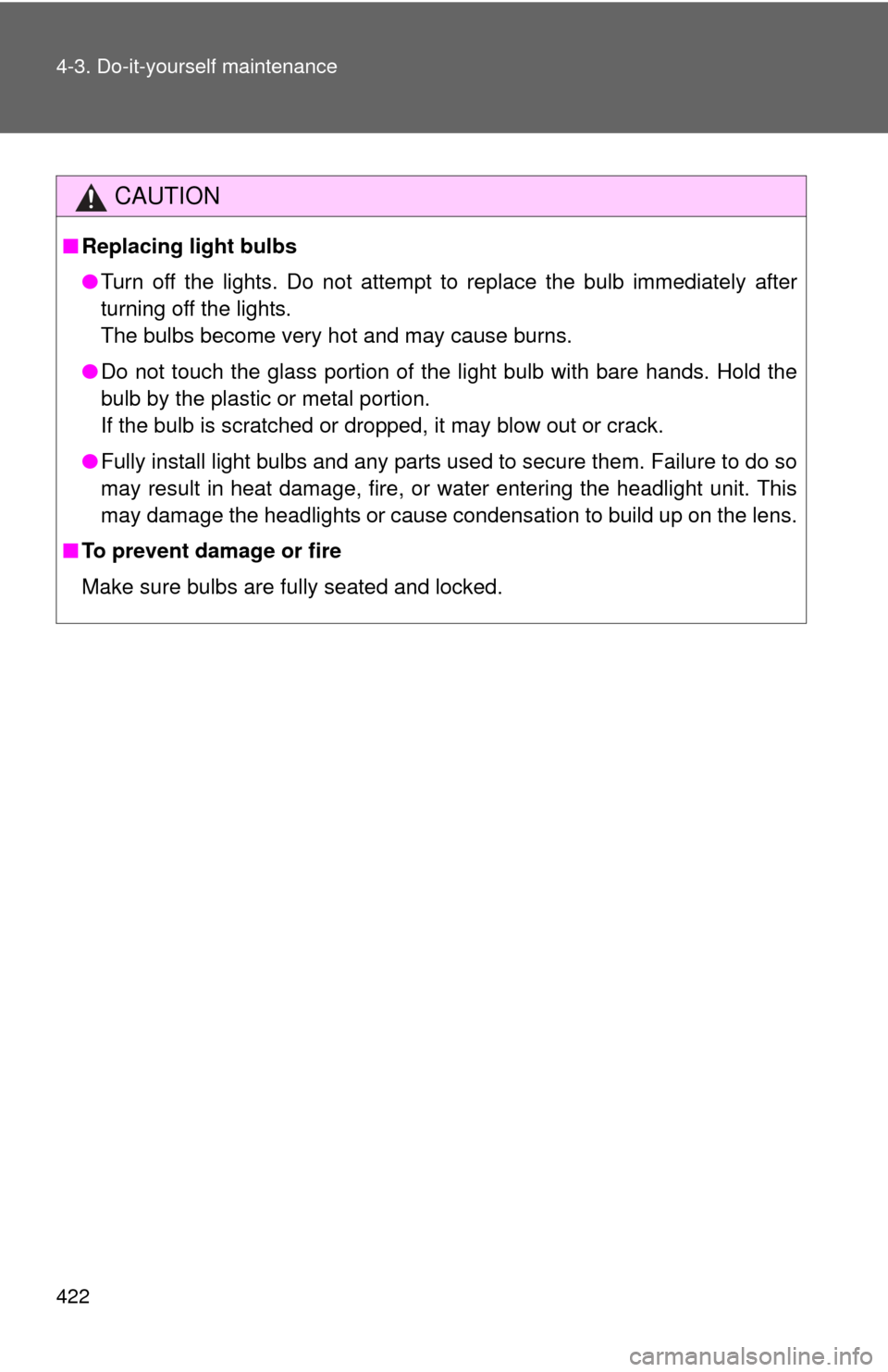
422 4-3. Do-it-yourself maintenance
CAUTION
■Replacing light bulbs
●Turn off the lights. Do not attempt to replace the bulb immediately after
turning off the lights.
The bulbs become very hot and may cause burns.
● Do not touch the glass portion of the light bulb with bare hands. Hold the
bulb by the plastic or metal portion.
If the bulb is scratched or dropped, it may blow out or crack.
● Fully install light bulbs and any parts used to secure them. Failure to do so
may result in heat damage, fire, or water entering the headlight unit. This
may damage the headlights or cause condensation to build up on the lens.
■ To prevent damage or fire
Make sure bulbs are fully seated and locked.
Page 439 of 552
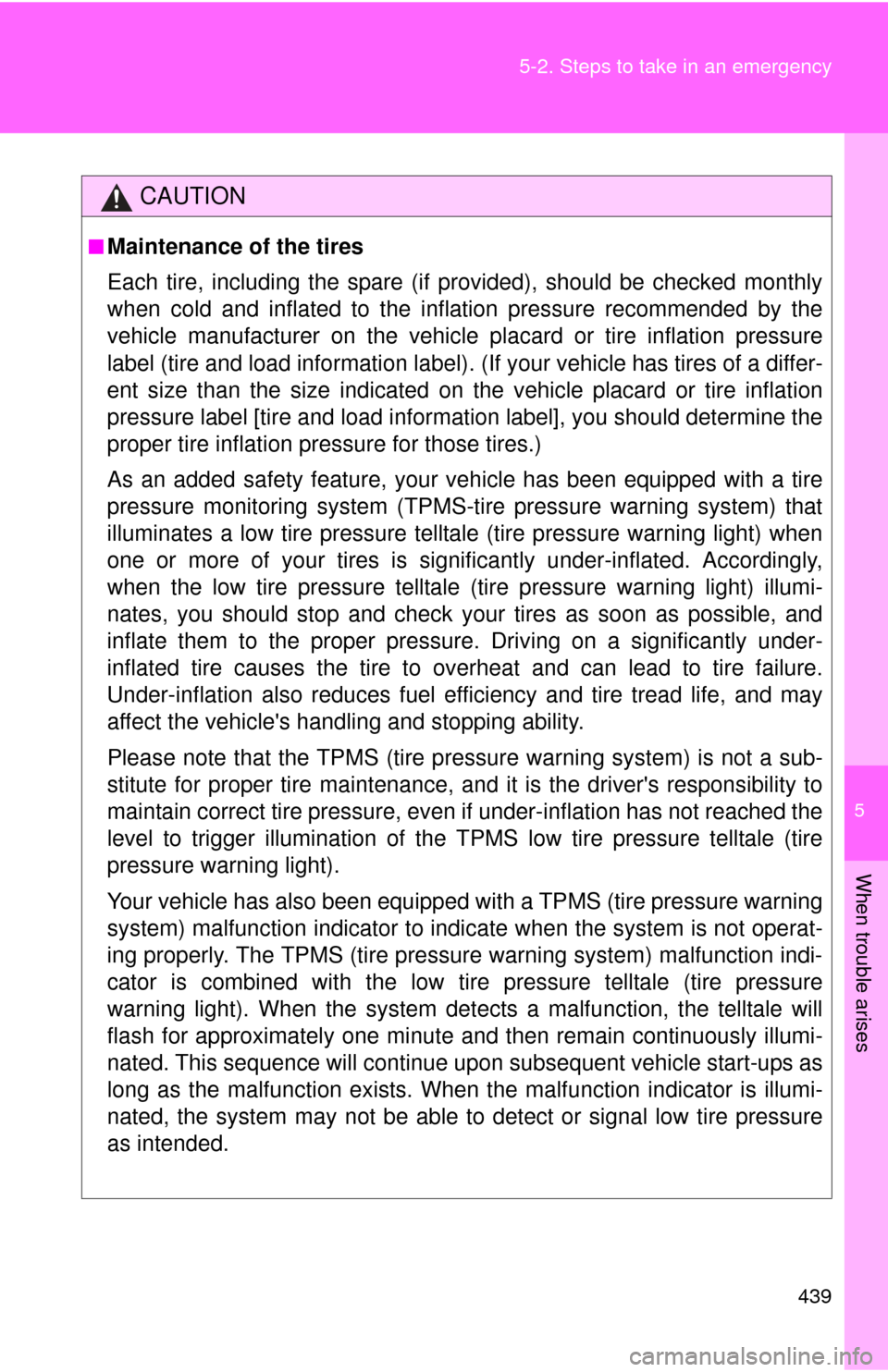
5
When trouble arises
439
5-2. Steps to take in an emergency
CAUTION
■Maintenance of the tires
Each tire, including the spare (if provided), should be checked monthly
when cold and inflated to the inflation pressure recommended by the
vehicle manufacturer on the vehicle
placard or tire inflation pressure
label (tire and load information label). (If your vehicle has tires of a differ-
ent size than the size indicated on the vehicle placard or tire inflation
pressure label [tire and load information label], you should determine the
proper tire inflation pr essure for those tires.)
As an added safety feature, your vehicle has been equipped with a tire
pressure monitoring system (TPMS-ti re pressure warning system) that
illuminates a low tire pressure telltal e (tire pressure warning light) when
one or more of your tires is significantly under-inflated. Accordingly,
when the low tire pressure telltale (tire pre ssure warning light) illumi-
nates, you should stop and check your tires as soon as possible, and
inflate them to the proper pressure. Driving on a significantly under-
inflated tire causes the tire to overheat and can lead to tire failure.
Under-inflation also reduces fuel effi ciency and tire tread life, and may
affect the vehicle's hand ling and stopping ability.
Please note that the TPMS (tire pressure warning system) is not a sub-
stitute for proper ti re maintenance, an d it is the driver's responsibility to
maintain correct tire pressure, even if under-inflation has not reached the
level to trigger illu mination of the TPMS low ti re pressure telltale (tire
pressure warning light).
Your vehicle has also been equipped with a TPMS (tire pressure warning
system) malfunction indicator to indi cate when the system is not operat-
ing properly. The TPMS (tire pressure warning system) malfunction indi-
cator is combined with the low tire pressure telltale (tire pressure
warning light). When the system det ects a malfunction, the telltale will
flash for approximately one minute an d then remain continuously illumi-
nated. This sequence will continue upon subsequent vehicle start-ups as
long as the malfunction exists. When the malfunction indi cator is illumi-
nated, the system may not be able to detect or signal low tire pressure
as intended.
Page 445 of 552
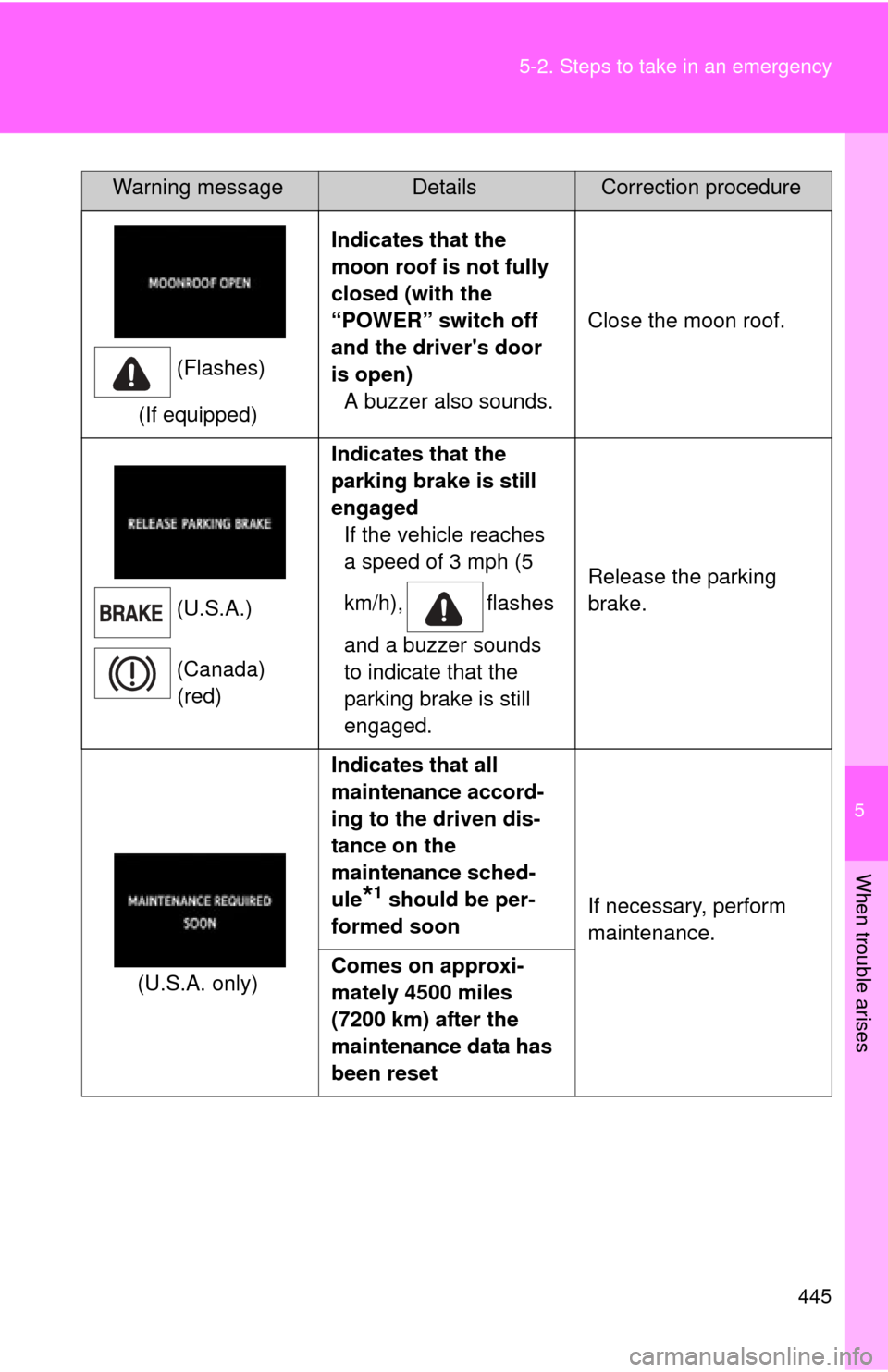
5
When trouble arises
445
5-2. Steps to take in an emergency
(Flashes)
(If equipped) Indicates that the
moon roof is not fully
closed (with the
“POWER” switch off
and the driver's door
is open)
A buzzer also sounds. Close the moon roof.
(U.S.A.)
(Canada) (red) Indicates that the
parking brake is still
engaged
If the vehicle reaches
a speed of 3 mph (5
km/h), flashes
and a buzzer sounds
to indicate that the
parking brake is still
engaged. Release the parking
brake.
(U.S.A. only) Indicates that all
maintenance accord-
ing to the driven dis-
tance on the
maintenance sched-
ule
*1 should be per-
formed soon If necessary, perform
maintenance.
Comes on approxi-
mately 4500 miles
(7200 km) after the
maintenance data has
been reset
Warning messageDetailsCorrection procedure
Page 446 of 552
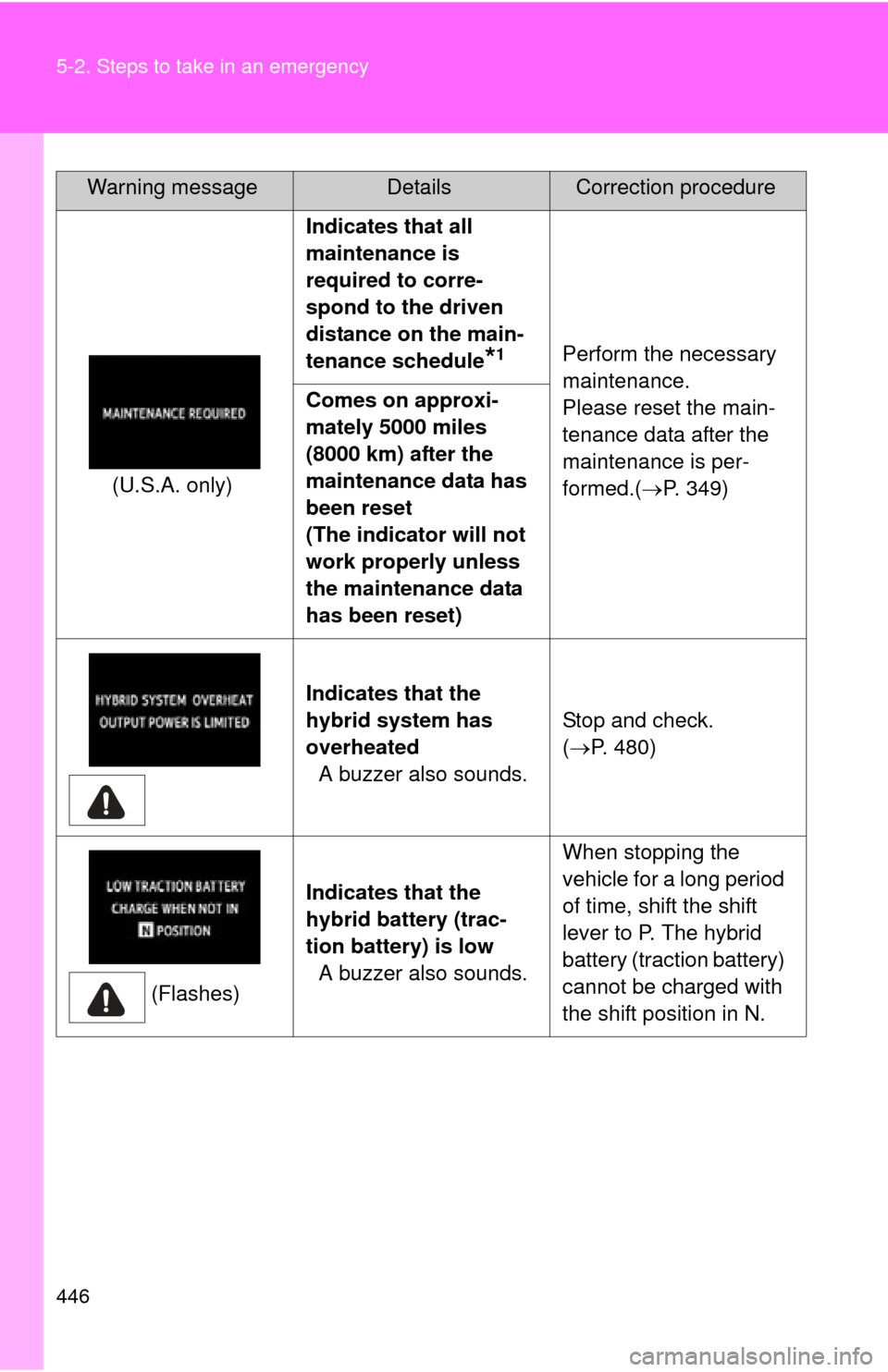
446 5-2. Steps to take in an emergency
(U.S.A. only)Indicates that all
maintenance is
required to corre-
spond to the driven
distance on the main-
tenance schedule
*1Perform the necessary
maintenance.
Please reset the main-
tenance data after the
maintenance is per-
formed.(
P. 349)
Comes on approxi-
mately 5000 miles
(8000 km) after the
maintenance data has
been reset
(The indicator will not
work properly unless
the maintenance data
has been reset)
Indicates that the
hybrid system has
overheated
A buzzer also sounds. Stop and check.
(
P. 480)
(Flashes) Indicates that the
hybrid battery (trac-
tion battery) is low
A buzzer also sounds. When stopping the
vehicle for a long period
of time, shift the shift
lever to P. The hybrid
battery (traction battery)
cannot be charged with
the shift position in N.
Warning messageDetailsCorrection procedure